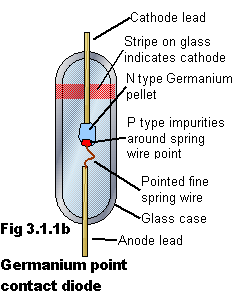Ge Single Diodes
What the parameters mean.
Depletion layer p.d.
The potential difference (voltage) set up in the depletion layer by the combining holes and electrons. This p.d. must be overcome for the diode to conduct. For a silicon junction the p.d is about 0.6V and for germanium about 0.2V.
Reverse leakage current.
When a PN junction is reverse biased in a transistor or a diode, a very small leakage current will flow due mainly to thermal activity within the semiconductor material "shaking loose" free electrons, which then form the leakage current. Typically a germanium device may have a reverse leakage current of several micro-Amperes but in silicon devices it is much smaller; only a few nano-Amperes
Forward current.
The maximum current a diode may pass when forward biased (anode + cathode -) without the device being damaged.
Max. reverse voltage.
The maximum voltage that may be applied to a diode when it is reverse biased (anode - cathode +) without damage to the device. (also called the Reverse breakdown voltage)
Temperature Stability.
The amount the current changes (rises) per degree Celsius from the normal value (usually measured at 70 degrees C)
Germanium Diodes.

Germanium diodes are a type that has been in use since the early days of radio and although they have been largely superceded by silicon signal diodes and integrated circuits, they may still be found as signal diodes in older radio circuits. They can be used with very small amplitude A.C. signal voltages in such applications as radio signal detectors (demodulators) in radio receivers. Because the voltages involved in demodulating AM radio signals are likely to be less than 1Vpp (0.5Vpk). A Silicon diode could not be used to efficiently rectify such a small waveform since it will not start to conduct until a forward voltage (positive on the anode) of 0.6V is reached. Fortunately Germanium diodes will conduct at a forward voltage of only about 0.15V. The demodulator that recovers the audio signal from the amplitude modulated AM) radio waves can use a germanium diode as a rectifier to recover the audio signal from the amplitude modulated radio signal. It works in a similar way to a rectifier diode in a simple power supply; it passes one half of the incoming radio signal and blocks the other half. The main differences being that the frequency of operation is much higher and the voltages used are tiny by comparison to a mains (line) power supply. The point contact diode illustrated in fig 3.1.1b has another useful advantage over the silicon rectifier; the area of junction is very small. This also means that the junction capacitance will be very small, much smaller than that of a Silicon junction diode.

A simple diode demodulator using germanium gives an output for smaller signals than is possible using silicon
The junction of a diode is basically an insulating layer (the depletion layer) sandwiched between two conductors; the P type and N type areas; it is actually a capacitor. The effect of this capacitor, if it is too large, will be to reduce the effectiveness of the circuit at high frequencies; the whole waveform will pass through the diode instead of one half cycle being removed by the rectifying action of the diode.Therefore at high frequencies no rectification takes place; just the frequencies we need it to work well at. The germanium diode, with its very small junction capacitance is ideal for the purpose.
The Germanium diode will not pass large currents - only a few milli-amperes but that is all we need in a radio application such as a demodulator. Germanium diodes are therefore useful for radio frequency circuits involving small amplitude signals.
The advantages and disadvantages of silicon and germanium diodes are summarised in table 3.1.1 below:
Table 3.1.1 Diodes
Parameter |
Germanium |
Silicon |
Comments |
|---|---|---|---|
|
Depletion layer p.d. |
0.15V |
0.6V |
Germanium can be useful for low voltage applications |
|
Forward current |
A few milli-Amperes |
Tens of Amperes |
Silicon much better for high current applications |
|
Reverse leakage current |
A few micro-amperes |
A few nano-amperes |
Germanium 1000 times more leaky than silicon |
|
Max. reverse voltage |
Volts |
Hundreds of volts |
Silicon the only real choice for high voltage applications |
|
Temperature stability |
Poor |
Good |
Germanium more sensitive to temperature. Can be a problem or can be useful |
|
Junction capacitance |
Very low (point contact) |
Comparatively high |
This is a useful feature for high frequency use. Note; low capacitance silicon diodes are also available but their capacitance is still higher than point contact type. |